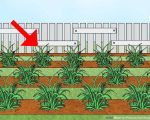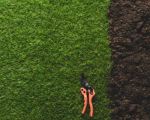How to Deal with Lawn Pests
If you're like me, you love spending time outdoors in your yard, but nothing can be more frustrating than seeing your lawn become a victim of pests. Lawn pests can destroy your grass, leaving patches of brown and bald spots that seem to spread quickly. Over the years, I've had my fair share of pest problems, and through trial and error, I've learned how to identify and deal with them effectively. In this article, I will walk you through the most common lawn pests, how to spot them, and the best ways to get rid of them, so you can enjoy a beautiful, healthy lawn once again.
1. Understanding Common Lawn Pests
Before jumping into solutions, it's important to know what you're dealing with. Lawn pests can come in all shapes and sizes, but the most common offenders are insects that feed on the grass and the roots. Here's a look at some of the most common lawn pests:
- Grubs: These are the larvae of beetles and are one of the most destructive pests for lawns. They feed on the grass roots, causing the grass to loosen and die. If you notice areas of your lawn that easily pull up or appear discolored, grubs might be the cause.
- Chinch Bugs: Chinch bugs suck the juices from the grass, causing it to turn yellow and die. They're often found in hot, dry areas of the lawn.
- Armyworms: These caterpillars can eat large patches of grass in a short time. They are most common in the fall and early spring.
- Fleas and Ticks: While fleas and ticks are more commonly associated with pets, they can also infest your lawn. These pests bite humans and animals, causing discomfort and potentially spreading diseases.
- Aphids: These tiny insects feed on plant sap, causing grass to wilt. They're often visible in clusters on the grass blades and may leave behind sticky residue.
Recognizing the type of pest is the first step in successfully dealing with it. Once you know what you’re dealing with, you can apply the right methods for control.
2. How to Identify Lawn Pests
Identifying lawn pests can be tricky, especially if you're not sure what you're looking for. In my experience, the best way to identify pests is by observing the symptoms on your lawn. Here are some key indicators:
- Discoloration: If your lawn is turning yellow, brown, or showing patches of dead grass, this could be a sign of pest damage.
- Unusual Damage: Look for areas where the grass pulls up easily or where there’s a spongy feel. Grubs, for example, cause the soil to become loose due to their feeding.
- Visible Pests: Sometimes, the pests themselves are easy to spot. Look for clusters of bugs on grass blades or notice insects flying or crawling around your lawn.
- Weakened Grass: If your grass appears to be struggling to grow, it could be a sign that pests are affecting its health.
Once you've noticed these signs, it's important to act quickly to prevent the pests from causing further damage. Early detection can save you time and effort in the long run.
3. Natural and Organic Pest Control Methods
When I first started dealing with lawn pests, I was hesitant to use harsh chemicals, fearing they might harm the environment or my pets. Fortunately, there are several natural and organic ways to tackle lawn pests without resorting to toxic pesticides. Some methods I’ve found to be effective include:
- Beneficial Nematodes: These microscopic worms can help control grubs and other soil-dwelling pests. They naturally seek out and kill pests in the soil without harming your lawn.
- Diatomaceous Earth: This natural powder is effective against a wide range of pests, including aphids and grubs. It works by dehydrating the pests when they come in contact with it.
- Neem Oil: Neem oil is a natural pesticide that can be used to deter a variety of pests, including aphids and armyworms. It’s safe for plants and doesn’t harm beneficial insects when used properly.
- Insecticidal Soap: This is a safe, eco-friendly option for controlling pests like aphids, mites, and other insects. It works by suffocating the pests.
Using natural methods has helped me keep my lawn healthy and pest-free without exposing the environment to harmful chemicals. While these solutions may take longer to show results, they are effective and safe for both pets and humans.
4. Chemical Control Methods
In some cases, natural methods might not be enough to control the pest population. If you’re dealing with a severe infestation, chemical control methods may be necessary. When considering chemicals, it’s important to choose the right product for the specific pest and follow the application instructions carefully.
Some common chemical treatments for lawn pests include:
- Granular Pesticides: These are spread across the lawn and work by killing pests when they come in contact with the granules.
- Liquid Insecticides: These are sprayed directly onto the lawn to target pests such as grubs, aphids, and chinch bugs.
- Fungicides: If your lawn has been affected by fungal diseases caused by pests, fungicides can help control the spread of the disease and protect your lawn.
While chemical treatments can be effective, I always recommend using them as a last resort and with caution. Be sure to follow all safety guidelines and avoid overuse to prevent damaging your lawn or harming beneficial insects.
5. Preventive Measures to Keep Your Lawn Pest-Free
Prevention is key when it comes to lawn pests. Over the years, I’ve learned that maintaining a healthy lawn is one of the best ways to keep pests at bay. Here are some preventive measures that can help:
- Regular Lawn Maintenance: Regularly mowing, fertilizing, and aerating your lawn can help keep it strong and healthy, making it less attractive to pests.
- Watering Properly: Watering deeply and infrequently helps the grass develop deep roots, which makes it more resilient to pest damage.
- Mulching: Mulching helps retain moisture and keep pests away by creating a barrier around the base of your plants.
- Keep Lawn Clean: Remove fallen leaves, debris, and thatch that can create hiding spots for pests.
By keeping your lawn healthy and well-maintained, you can reduce the likelihood of pests settling in and causing damage in the first place.
SEO Title: How to Deal with Lawn Pests SEO Keywords: lawn pests, lawn care, pest control, grubs, aphids, beneficial nematodes, natural pest control, chemical pesticides SEO Description: Discover how to deal with lawn pests effectively with both natural and chemical solutions. Learn to identify, control, and prevent pests like grubs and aphids on your lawn.







